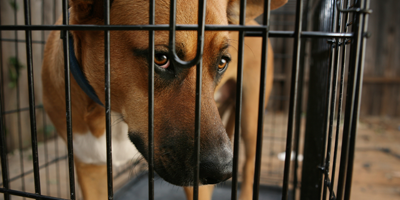Which Animals Are Used
Dogs

Although it’s hard to imagine, dogs have long been used as research and testing subjects. In fact, in 1883, AAVS was founded specifically to protect dogs from being stolen or otherwise collected off the streets so they could be used in research and medical school education, often suffering in agony with no analgesic or pain relief. This continued through the first half of the 20th century without regulatory oversight, until 1966 when the Animal Welfare Act (AWA) was enacted, spurred in part by the death of Pepper, a Dalmatian who was stolen from her family in Pennsylvania, transported to New York, sold to a lab by an animal dealer, and then killed during an experiment. Although animal research and testing are now regulated, the AWA does not restrict the use of certain types of animals, including former pets, and dogs are still used in experiments today. Over 47,200 dogs were used in laboratories in 2023, according to AAVS analysis of data released by the U.S. Department of Agriculture (USDA).
HOW DOGS ARE USED
Dogs are often used in biomedical research investigating heart and lung disease, cancer, and orthopedics. They are also used in toxicity studies to test the effects of drugs, medical devices, and agricultural chemicals, subjected to extreme doses, which cause immense suffering. The most common breed of dog used for experiments is the beagle, because beagles are docile and small, allowing for more animals to be housed and cared for using less space and money.
WHERE LABS OBTAIN DOGS
Most dogs used in research are purpose-bred in laboratory breeding kennels, private companies that sell strictly to labs. Dogs can be bred to be pathogen-free or genetically manipulated to be a model of human disease. To acquire dogs with specific traits who are not readily available from breeders, some research facilities obtain dogs directly from pounds and shelters, a practice called pound seizure. These labs may want older dogs to use in age related research or larger dogs to study heart disease. Also, medical and veterinary schools have traditionally used dogs from shelters for student training, particularly for surgery. Now the trend is to utilize alternatives that do not harm animals and allow veterinarians to gain experience through beneficial shelter medicine programs.
Previously, facilities could purchase dogs from random source Class B dealers, who acquire animals from pounds and shelters and then sell them for use in research. Random source dealers had a long sordid history of violating the AWA until they were finally put out of business thanks to a provision included in the FY 2023 Consolidated Appropriations Act.Over 47,200 dogs were used in laboratories in 2023,
